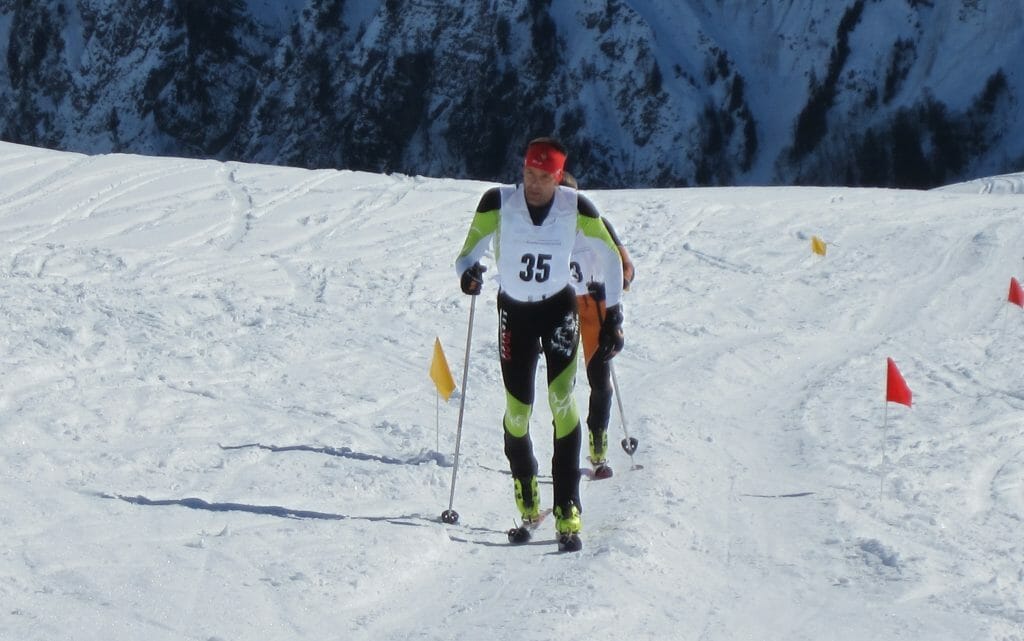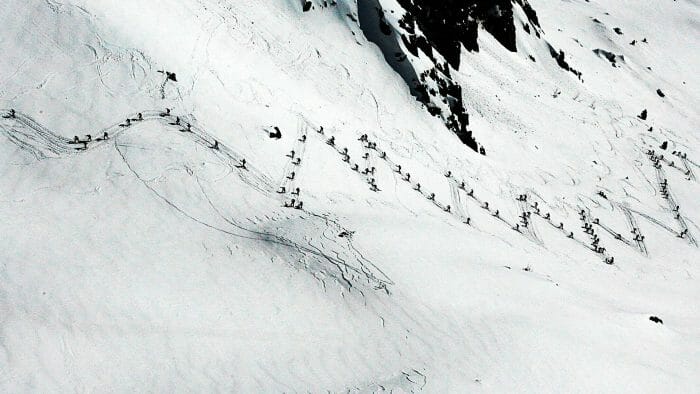Skimo racing is hands down the hardest aerobic work I’ve done in my endurance career. The full-body engagement and use of both legs and arms to propel myself uphill causes me to taste blood much quicker than in any running race I have ever participated in. I love that about the sport, and without a doubt it’s imperative to work hard on preparing your heart and lungs as best you can before your first (or 10th) skimo race season. With that said, you can have the world’s highest VO2max, but if you do not know how to do a quick transition, knock out an effective kick turn, or keep your water from freezing in a race, you will race nowhere near your potential. If you are in search of efficiency, as I always am, you can make huge gains in your skimo racing by honing the various skills needed to move fluidly through the complex terrain of a skimo race course.
10 Skimo Racing Skills to Practice in Training
Below are 10 skills I practice and prioritize in training in order to be as efficient as possible on race day so I can perform my best. This information is useful no matter your gear setup or your objective: all of these skills can make you not only a faster skimo racer but also a more efficient backcountry skier or snowboarder. One bonus of training for skimo racing is that my backcountry tours have become far more efficient in recent years—more miles, more vert, and, most importantly, more pow turns.
Trying to focus on all skills all the time is a shortcut to getting overwhelmed. It’s best to work on only one or two while out on any given training day. If you commit to improving these skills over the course of your skimo season, you will no doubt continue to close the gap between your performance and your potential.
1. Transitions
This is a no-brainer. Transitions, which occur up to a dozen times in a race, can make or break your performance. Skinning to skiing, skiing to skinning, skinning to bootpacking, bootpacking to skiing—all of these transitions, if done well, can put major time in the bank. However, if done poorly, they can cost you multiple minutes in a race, where often just a few seconds constitute the difference between making the podium and missing out.
At the end of a training session, set aside time to practice both skins-on and skins-off transitions. If possible, film yourself and watch later to see what works and what does not. At the very least pay attention to how you do each type of transition and think about ways to improve it. The overall goal is to be so dialed in your transitions that they become reflexive, and you don’t have to waste energy thinking about them in the more stressful environment of a race. Aim to do each transition a dozen times.
2. Kick Turns
Most skimo races and backcountry ski outings involve a lot of kick turns as you switchback up a steep slope. I’ve won and lost races due to my ability, or inability, to do a kick turn well. Just like transitions, the time saved from doing a single kick turn efficiently may not seem like much, but over the course of 60 or 70 repetitions the savings add up. To practice this essential movement, set a track up a short climb with 10 to 15 kick turns packed tightly together and move through it multiple times to dial in your form and technique. Start by doing it at an easy and controlled pace so that you can focus on your technique and not worry about effort. The idea is to have your kick turns become very quick, efficient, and snappy. This way in a race setting you do not lose time to your competitors because you’re struggling on technical kick turns.
3. Bootpack Transitions
At the end of a training session, set aside time to practice your bootpack transitions. Set a small bootpack that allows you to focus on the transition from skinning to bootpacking and then from bootpacking back to skinning. Go through this at least a dozen times. This is about honing your skills for efficient transitions, not about hammering through the bootpack, so keep your aerobic effort easy. Also spend time thinking about how to best use your poles. Are you planting your poles once and then making multiple steps, or are you alternating pole planting with each step? Focus on finding an efficient system that works best for you.
4. Gear Management
With all this focus on heart rate, intervals, and endurance, it’s easy to overlook something as important as optimizing your systems for carrying and managing your gear in a race. Think about how and when you want to stow or use your gloves, your goggles, your poles, and your nutrition and hydration over the course of a long training session or race. Is your windbreaker easy to access if you know you will be on a cold and windy ridge? What if your current skins fail? Where are your backups? Is your water easily accessible but in a warm enough place to prevent freezing? Where do you place your poles when you are doing a transition? If you are a geek like me, you will enjoy the process of rooting out inefficiencies with your gear that you never knew existed.
5. Downhills
Ski mountaineering is all about the uphill … except when it’s not. Too often athletes forget to develop their downhill skiing prowess as well. Make it a point at times in your training to ski down hard, the same way you ski up hard. The downhills are part of the race, too, and you need to be ready to press downhill on your skinny sticks without your quads screaming too loud at you.

6. Kick and Glide
Sure, this isn’t a classic ski race, and the glide you get with skins on your skis may pale in comparison, but the idea here is to get the most out of your strides. If you are able to maintain your cadence while getting just a little more distance out of each stride, it will pay dividends over the length of a course. Keep this in the back of your mind as you train. Are you maintaining the most effective stride length you can achieve? Are you snapping your hips? Are you driving forward? Are you transferring power from your pole plant through your core to your ski? These are all good questions to ask while in the skin track. And they also provide you with a good answer for the next time someone asks you what you think about during all those long, cold, and lonely training sessions.
7. High Cadence
Make a point from time to time to find a more gradual slope, or cat track, to ski up. When you do, work on maintaining a higher cadence than you may normally have while grinding up a steeper hill. If the majority of your training comprises steep grinds up ski slopes, you risk losing efficiency at a higher leg turnover. Instead, find a gradual slope and settle into a higher cadence. This will help keep your fast twitch muscles engaged and awake, and it’s an opportunity to practice your kick and glide. Plus, it just feels good.
8. Mini Race Course
This is your opportunity to put together many of the skills you have worked on before heading into your race season. By doing hard efforts through a small race course, you can really hone your efficiency while pinpointing which skills are strengths and which are still weaknesses. I like to set up a course that opens with an uphill skin that incorporates a few switchbacks, then goes to a bootpack, then back to a skin before reaching the top. I then do a quick transition and ski back down to the bottom as fast as possible. A really good workout is to set up a course that takes 12 minutes to complete and then go through it fast three times as an interval session.

9. Nutrition and Hydration Strategy
It’s so important before heading into the first races of your season to have a nutrition and hydration plan, and to have practiced that plan. Nutrition is a very personal journey and I won’t claim to tell you what works, but I will stand by the advice that the more time you take to practice and adjust your strategy, the better. This will yield more consistent results in the long run. Simply put, find what works for you during your workouts and longer skis so that you are already well prepared when race day comes.
10. Race Planning
You are physically and mentally prepared for this race. Your transitions are quick as lightning, your kick and glide are maximized, your kick turns are smooth as butter, and your downhill skiing is next level, but do you have a plan? Don’t let your foot off the gas now! Have you analyzed the course profile? Have you visualized where you want to push and where you want to settle in? Have you thought about how the course plays to both your strengths and weaknesses? When do you plan to eat: during the second 60-miles-per-hour descent or just before the fourth climb, when you know you will need the fuel?
If possible, ski around and check out sections of the course at an easy pace the day before the race. Like in most sports, course knowledge is hugely advantageous in skimo racing.
This article was originally published by Mike Foote.

